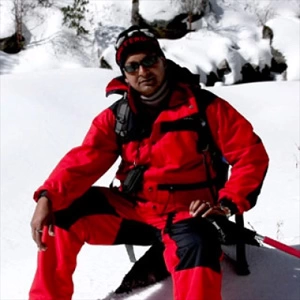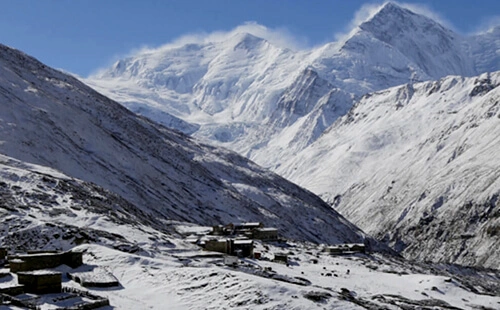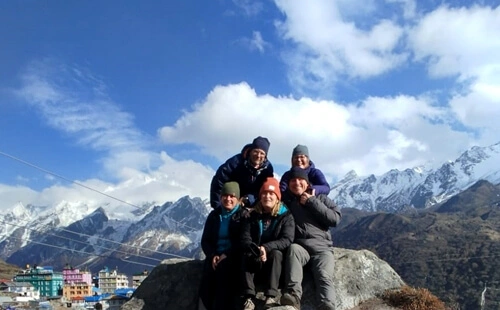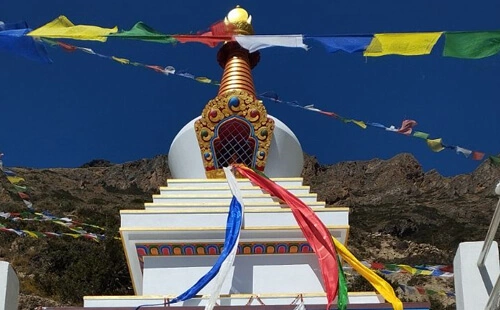Understanding the Manaslu Trek Altitude and Height
Soti Khola, at an elevation of around 700 m, is the common trek starting point for various Manaslu trekking routes, from less-trodden ones such as the Tsum Valley Trek and the combined trek to Tsum Valley and Manaslu to the classic Manaslu Circuit Trek of 15 days and the Manaslu and Annapurna Circuit Trek. While the Nar Phu Valley Trek begins from Kota, understanding of the Manaslu Trek height is necessary.
Here’s the quick overview of the Manaslu Trekking altitude for those following the standard route or joining the main trail later on, after the journey begins from Soti Khola:
- Soti Khola (700m) → Maccha Khola (869m) → Jagat (1,340m) → Deng (1,860m)
- Deng→Namrung (2,360 m)→Sama Gaou (3,520 m)→Samdo (3,790 m)
- Dharamsala, also called Larkya La Phedi (4,450 m) → Larkya La Pass (5,106 m)
- Larkya La Pass→Bhimthang (3,700 m)→Dharapani (1,860 m)→Besisahar (760 m)
How does high altitude affect your body?
With the increase in Manaslu Circuit Trek altitude or any other Manaslu Trek high altitude gain, the air gets thinner and the oxygen level decreases. From 21% at sea level and 5,000 m and above, it drops to around 11%; therefore, the body must work extra to balance the supply to the brain and muscles. Rapid ascents mean you do not get enough time to acclimatize and can trigger altitude sickness.
Also called hypoxia, the early warning signs include headache, fatigue, dizziness, loss of appetite, and nausea. 3,000 m above sea level in the remote Himalaya of Nepal, it can concern anyone regardless of their age and experience level. Young or aged trekkers, beginners or seasoned trekkers, the essential tip for the Manaslu altitude trek is to give yourself time to adapt to the high altitude environment.
The risk of altitude sickness on the Manaslu Trekking Trail
Since the Manaslu Circuit Height reaches beyond 5,000 m and the other Manaslu Trek Altitude is 3,000 m above sea level, trekkers are highly exposed to alpine trekking and climbing conditions. That is why it is a must that you are aware of all the symptoms of altitude sickness, which can be life-threatening if ignored. Acute mountain sickness (AMS), showing symptoms as mentioned above, is mild and moderate.
But HAPE (High Altitude Pulmonary Edema) and HACE (High Altitude Cerebral Edema), including symptoms like problems in breathing and constant coughing due to fluid accumulation in the lungs, confusion, sudden loss of balance, and sometimes even unconsciousness due to fluid accumulation in the brain, are fatal. The key is proper acclimatization, early detection, and action.
Is acclimatization crucial for trekking to Manaslu?
Yes, absolutely, when you are on a journey like the Manaslu Circuit Altitude trek, reaching challenging high mountain passes like Larkya La Pass (5,106 m), acclimatization is a must, especially if you are choosing high-altitude treks like the Manaslu Circuit Hiking as a first-timer. Choose an itinerary that allows ample time for exploration and rest, such as those from Adventure Himalayan Travels and Treks.
Other high-altitude health tips in Nepal for those trekking to Manaslu for proper acclimatization are to hike up and sleep. Listen to your body and maintain your pace; do not rush your steps at all. Alcohol can cause dehydration; instead, purchase a 1L metal bottle to refill with lukewarm drinking water along the teahouses and keep yourself hydrated. Ginger and garlic soup is found to work as a natural remedy. Consider adding it to your menu.
Do’s and Don’ts on suffering from altitude sickness
Once you observe symptoms of acute mountain sickness (AMS), to prevent it not getting further serious, stop ascending right there. Do not attempt another Manaslu Trek height altitude at all. If possible, descend immediately; if not, rest for a while, do not overexert yourself, stay hydrated, and use oxygen if available. During this time, experienced guides assist you immediately and also inform the concerned authorities of further help.
That is also why comprehensive high-altitude coverage travel insurance is recommended. On purchasing one with medical bills, emergency helicopter evacuation, loss and theft of goods, trip cancellation, and delays, you have peace of mind and invest yourself in enjoying the journey completely. Since descent is the only cure, those with travel insurance can get you directly flown over to a low altitude and save your life.
How to traverse through the Larkya La Pass?
The maximum Manaslu height during most of the Manaslu treks, including the Manaslu Circuit Trip, is 5,106 m/16,752 ft above sea level at Larkya La Pass. Unless and until you are journeying for the Manaslu Expedition or joining the combined circuits trek to Manaslu and Annapurna, Larkya La Pass is the most rewarding as well as challenging part of the journey. Rugged, remote, thin air, and unpredictable weather—it is demanding.
Steep ascent at first, then descent to Bhimthang; long hours of walking mean that, along with a good level of physical fitness, mental resilience also should be excellent. Afternoon winds are strong and can obstruct the views and the path; therefore, get ready to begin hiking even before dawn. Consider medication like Dimox to prevent altitude sickness, dress in layers, and follow the lead of your guide.
Weather and temperature at Manaslu Trek Altitude
The weather is a crucial factor that will determine the nature of your journey to the high-altitude Himalayas in Nepal, including the Manaslu Trekking altitude. At higher altitudes, Himalayan weather tends to be fickle, meaning it can change at any time. Temperature also drops significantly, especially at night, and often goes below the freezing point precisely in places like Dharamsala and Larkya La Pass.
The lower Manaslu Circuit Altitude and Manaslu Trek Altitude below 2,000 m are warm and humid. At mid altitude (2,500 m - 3,500 m), the Manaslu Trekking Region features cooler temperatures between 10 and 15 degrees Celsius. Therefore, pick the optimal time for the best experience, and for high-altitude treks and climbs, it is spring (March-May) and autumn (Sept-Nov). If packed well, a summer/monsoon trek is also enjoyable.
Why are mental and physical preparation crucial?
Especially for beginners, your success rate of conquering Manaslu's highest point and surviving the Manaslu Trek's high-altitude challenges requires adequate mental and physical preparation. A convenient option for seasoned trekkers seeking solitude and isolated experiences, it is good to begin cardiovascular training, practice hiking with a backpack, do altitude training (if possible), and mental preparation at least a month before.
Consider activities like hiking, running, swimming, or cycling to build endurance. To get used to the Manaslu Trek's high-altitude hiking conditions, it is good to traverse the local terrain with a backpack. It is to help your body adapt to the weight and pressure on the knees and shoulders. For better mental preparation, do research and collect knowledge of high-altitude health tips for Nepal and other essential tips for the Manaslu altitude trek.
What are the essential gears and equipment for the Manaslu Trek height?
Proper clothing, gear, and equipment are other essentials one should always be thoughtful of while on alpine rambling in Nepal, such as in the Manaslu Trekking region, the Manaslu Circuit Trek. Appropriate packing lists ensure increased mobility and comfort, and also that you stay warm in cold temperatures at high altitudes and at night. So one of the essential tips for the Manaslu altitude trek is to dress in layers.
A moisture-soaking base layer, an insulating mid-layer (fleece/down), and a waterproof/windproof outer shell. Sturdy, broken-in trekking boots, poles, first aid kits, and personal medications, if you are taking any, are a must. To stay warm and make it safely through the Manaslu Trekking Altitude, precisely the Manaslu Circuit Trek Altitude, warm accessories like a hat, gloves, buff, sunglasses, and sunscreen are not to be missed.
High Altitude Health Tips for Nepal Trekkers
- Once you get into the Manaslu Trekking route, ascend gradually; remember the golden rule: hike up, sleep low, and eat healthy.
- A healthy diet is rich in carbs and proteins, so it is good to stick to Dal-Bhat-Tarkari (a staple Nepalese dish) and better to avoid meat products since they are often carried up from below and can be stale.
- Rehydrate as much as possible, but do not directly consume the water from natural sources like rivers, streams, and taps. It can be contaminated.
- Alcohol, tobacco, cigarettes, and sleeping pills must be avoided while ascending. Valid for the popular Everest Base Camp Trek, the Annapurna Base Camp Trek, and the Langtang Valley Trek.
- Listen to your body, take breaks, and rest whenever necessary; if suffering from any permanent illness, consult with doctors at first.
Conclusion
The Manaslu Trek provides you with a once-in-a-lifetime experience traversing through the remote, restricted, and less-trodden trails. Solo trekking is banned, and mandatory hiring of licensed guides means safety is paramount. The Manaslu Trek altitude reaches beyond 3,000 m above sea level; being aware of the Manaslu Circuit Height means a profound sense of achievement is there through diligently following high-altitude health tips in Nepal.
With more organizing hassle-free than two decades of experience in organizing hassle-free treks, tours, climbs, and expeditions not only in the Himalayan country of Nepal but also in Tibet and Bhutan at Adventure Himalayan Travels and Treks, you are in safe and reliable hands. We ensure your legitimate, authentic, and eco-friendly Himalayan holidays. Contact us and reserve your seat. Bookings are now open for 2026 and 2027.
FAQS
Do you need a special permit for trekking to Manaslu?
Yes, since the Manaslu treks, including the Manaslu Circuit hiking, are through one of the restricted areas, trekkers and climbers—anyone entering the region of outdoor activities—must get a special restricted area permit (RAP) in addition to TIMS and Conservation area permit.
Solo vs guided Manaslu Trek: which is better?
Free individual trekkers (FITs) in Nepal’s national parks, conservation areas, and restricted areas have been banned since April 1st, 2023. Guided treks come with expert guidance, immediate assistance in emergencies, and more interactive cultural immersion. Either way, a guided trek to Manaslu is way better with legal access.
Can you find an ATM during the trekking journey to Manaslu?
No, in the remote area where the raw Himalayan wilderness is at its peak, infrastructures are very limited, and ATMs are not available on the Manaslu trekking routes. Therefore, carry enough Nepalese rupees from Kathmandu or stop by city areas and withdraw the needed amount.
Where to refill drinking water on the trekking trail to Manaslu?
Like the food and accommodation, teahouses dotted along the Manaslu hiking trail provide you with lukewarm boiled drinking water to refill throughout the trip. Usually, at some extra cost, it is the boiled drinking water that is the safest one, while bottled water is usually not recommended.
Must you join a group for Manaslu treks?
While the more people, the merrier the journey becomes, we are offering a customization option for you. Family, private, or couple? We can arrange it for you. However, it is a must that there are at least two people in your team and that it is accompanied by a licensed local guide, such as from Adventure Himalayan Travels and Treks.




